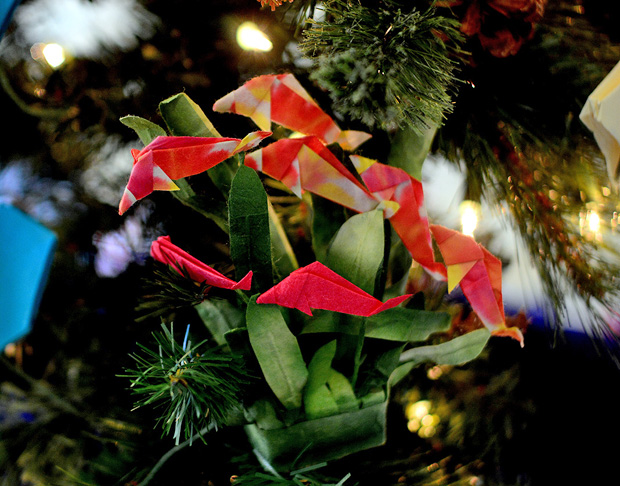

A unique holiday tree is now on display in the atrium of the ʻImiloa Astronomy Center of Hawaiʻi at the University of Hawaiʻi at Hilo. The tree is decorated with nearly 100 origami ornaments designed around the theme, “Creatures of the Sea,” and folded by artists from several continents. A seven-foot lighted tree serves as a backdrop for colorful paper schools of fish, sea mammals, seaweed, sea shells, and even a diver in scuba gear.
Origami is the art of paper folding, where flat sheets of paper are transformed into sculpture by folding and sculpting. The word origami is derived from the Japanese “ori” meaning “folding,” and “kami” meaning “paper.” Recently, ʻImiloa Astronomy Center has sponsored programs and workshops exploring scientific applications of origami—the Japanese art of paper folding can help scientists find and study Earth-like planets in the habitable zones of nearby stars, and maybe one day aid travel to one of these exoplanets.
“Exploring the intersections of paper folding and science has been an exciting new programming arena here at ʻImiloa, and we are happy that our origami holiday tree will continue this theme and give the community another reason to come in and visit,” says Kaʻiu Kimura, ʻImiloa’s executive director.
A joint folding effort
The folding of the tree ornaments was done in Hawaiʻi and across the continental United States, Europe and South America. The artists are some of the leaders of the modern origami movement, including Michael LaFosse and Richard Alexander of Origamido in Massachustts and Sok Song of New York City.

Swimming around ʻImiloa’s tree are angel, angler, box, damsel and butterfly fishes and yellow tangs, mahimahi and mempachi, marlin, sharks, barracudas, sea horses, sea snails, crabs, moray eels, manta rays, a coelacanth, an octopus family, a humpback whale and her calf and even Hawaiʻi’s state fish, the humuhumunukunukuapuaʻa.
The Kusudama star on the top of the tree was folded locally for ʻImiloa by Julien Lozi, senior optical scientist at Subaru Telescope, from a pattern designed by Ekaterina Lukasheva.
Viewing hours
ʻImiloa’s origami tree will be on display into January in the center’s atrium at 600 ʻImiloa Place in Hilo, off Komohana and Nowelo Streets at the UH Hilo University Park of Science and Technology. The ʻImiloa Astronomy Center is open to the public Tuesday through Sunday, from 9 a.m. to 5 p.m. For more information, visit the ʻImiloa website or call (808) 969-9703.
For more photos go to the UH Hilo Stories article.
—By Susan Enright

